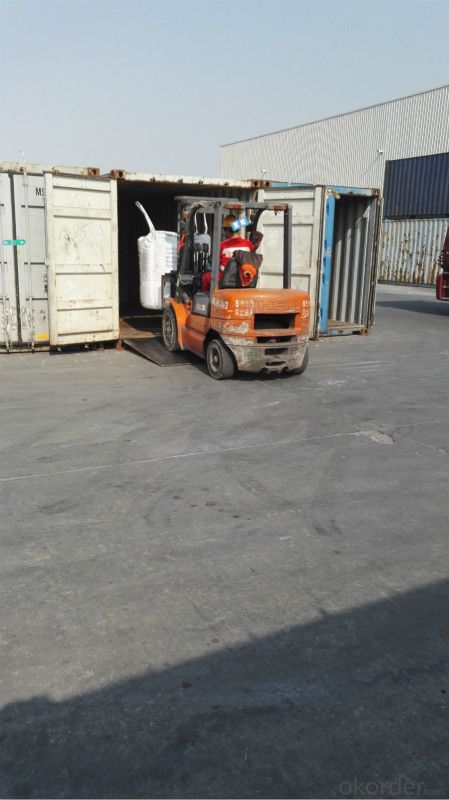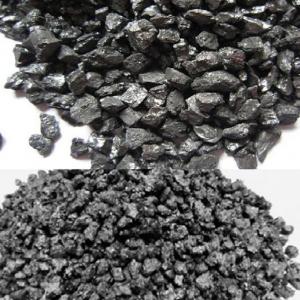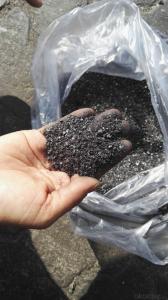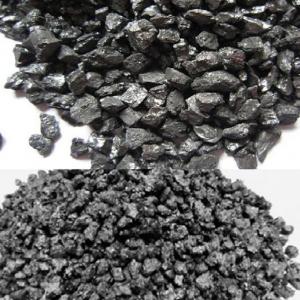Fixed carbon 90 Calcined anthracite as carbon additive
- Loading Port:
- Tianjin
- Payment Terms:
- TT /LC
- Min Order Qty:
- 20 m.t.
- Supply Capability:
- 10000 m.t./month
OKorder Service Pledge
OKorder Financial Service
You Might Also Like
Item specifice
Introduction
Carbon additive comes from delayed coke which extracted from oil refinery. Although carbon additive contains a little bit higher level of sulfur and nitrogen than pitch coke, the price advantage still makes it widely used during steel-making and founding as a kind of carbon additive/carburant. We provide carbon additive to steel plant to increase the carbon amount.
Features
Carbon Additive also called Calcined anthracite Coal, Gas Calcined Anthracite Coal, Carbon Raiser, Recarburizer, injection coke, charging coke and etc.
The main raw material of our Carbon Additive is Ningxia unique high quality Taixi anthracite, with characteristic of low ash and low sulfur. Carbon additive has two main usage, fuel and additive. When being used as the carbon additive of steel-smelting, and casting, the fixed carbon may achieve above 95%.
Best quality Taixi anthracite as raw materials through high temperature calcined at 1200-1250 ℃ for 24 hours by the DC electric calciner with results in eliminating the moisture and volatile matter from Anthracite efficiently, improving the density and the electric conductivity and strengthening the mechanical strength and anti-oxidation, It has good characteristics with low ash, low resistivity, low carbon and high density. It is the best material for high quality carbon products, it is used as carbon additive in steel industry or fuel.
We have the honor to be steady supplier of major steel company in Saudi Arabia, Philipines, Australia, Japan and other counties in the world
Specifications
PARAMETER UNIT GUARANTEE VALUE | |||||
F.C.% | 95MIN | 94MIN | 93MIN | 92MIN | 90MIN |
ASH % | 4MAX | 5MAX | 6MAX | 7MAX | 8MAX |
V.M.% | 1 MAX | 1MAX | 1.5MAX | 1.5MAX | 1.5MAX |
SULFUR % | 0.5MAX | 0.5MAX | 0.5MAX | 0.5MAX | 0.5MAX |
MOISTURE % | 0.5MAX | 0.5MAX | 0.5MAX | 0.5MAX | 0.5MAX |
Pictures


FAQ:
What is the packing?
In 25kg bag/ In jumbo bags without pallet/ Two jumbo bags with one pallet/ or as customers’ request
2. What is the production capacity?
10 thousand tons per month
3 What is payment term?
Irrevocable LC at sight/ 20% down payment by T/T and 80% against BL copy byT/T/ or to be discussed
4 What is the service?
We will send sample to the third party(CIQ, CCIC, SGS,BV or to be discussed) for checking, and present the test certificate and loading repot of shipment.
- Q:What is carbon fixation?
- Carbon fixation is the process by which carbon dioxide (CO2) from the atmosphere is converted into organic compounds by living organisms, mainly plants and algae. It is an essential part of the natural carbon cycle and plays a crucial role in sustaining life on Earth. During photosynthesis, green plants use sunlight, water, and CO2 to produce glucose and oxygen. This glucose serves as a building block for other organic molecules such as carbohydrates, lipids, and proteins. Carbon fixation is not only important for plant growth and development but also for the overall balance of atmospheric CO2 levels. It helps to mitigate the greenhouse effect by removing CO2 from the atmosphere and storing it in biomass or in the soil. Additionally, carbon fixation is a vital source of energy and nutrients for other organisms that consume plants or algae. Overall, carbon fixation is a fundamental process that contributes to the stability and functioning of ecosystems and has significant implications for climate change and the global carbon cycle.
- Q:What is carbon fixation in biology?
- The process of carbon fixation in biology involves the conversion of atmospheric carbon dioxide (CO2) into organic compounds by living organisms. This is a crucial step in the global carbon cycle and is primarily carried out by autotrophic organisms such as plants, algae, and certain bacteria. During the process of carbon fixation, the enzyme RuBisCO (ribulose-1,5-bisphosphate carboxylase/oxygenase) facilitates the reaction between CO2 and a five-carbon sugar molecule called ribulose bisphosphate (RuBP). This reaction produces two molecules of a three-carbon compound known as 3-phosphoglycerate (3-PGA). This initial step is referred to as the Calvin cycle or C3 photosynthesis. In plants, the 3-PGA molecules are then transformed into other organic compounds, including sugars, starches, and cellulose, through a series of enzymatic reactions. These organic compounds serve as the building blocks for the growth and development of the plant. Carbon fixation plays a crucial role in maintaining a balance of atmospheric CO2 levels and is a key process in regulating climate change. It allows for the transfer of carbon from the atmosphere to the biosphere, ultimately reducing the concentration of greenhouse gases and mitigating the impacts of global warming. Additionally, carbon fixation is essential for sustaining life on Earth as it forms the basis of food chains and supports the growth of other organisms. Heterotrophs, such as animals and humans, rely on the organic compounds produced by autotrophs through carbon fixation for their energy and nutritional requirements. In conclusion, carbon fixation is a fundamental biological process that facilitates the conversion of atmospheric carbon dioxide into organic compounds. It sustains life on Earth and aids in the regulation of the planet's climate.
- Q:They include a cementite, two cementite, three cementite, eutectic cementite and eutectoid cementite, and compare their temperature, composition and morphology
- Two: cementite in iron graphite phase, carbon content more than 0.77%, in A (Fe + Fe3C) two-phase region precipitation of Fe3C is two times the cementite formation temperature in the eutectic temperature (1148 DEG C) and eutectoid temperature (727 DEG C), morphology of the mesh is a typical carbon content. From 0.77% to 6.69% is the typical composition range.
- Q:How does carbon contribute to the color of gemstones?
- Carbon contributes to the color of gemstones through its ability to absorb certain wavelengths of light. When carbon is present in gemstones, it can create various color centers that give the gemstone its distinct hue, such as yellow in diamonds or blue in sapphires.
- Q:Joint carbide gas incident
- After a lapse of 25 years, a India District Court on 1984 Bhopal gas leak to be long in coming judgment, Union Carbide (India) Co., Ltd. 7 India nationals day was held for negligence causing death, they will face up to two years in prison. On the same day, hundreds of survivors, family members and environmentalists gathered around the courthouse to protest the court's decision that the perpetrators of the worst industrial disaster in twentieth Century were too light and too late. In 1969, Union Carbine Co established a Union Carbide in central India state of Bhopal Beijiao city (India) Co. Ltd., specializing in the production of aldicarb, carbaryl pesticide drops. The chemicals used in these products is called a methyl isocyanate poisonous gas. The early morning of December 3, 1984, this factory storage explosive liquid methyl isocyanate the steel tank, 45 tons of poison gas leak quickly, directly killed more than 1.5 people, allegedly have caused more than 550 thousand people died and chemical poisoning related lung cancer, renal failure and liver disease.
- Q:What does carbon burning mean?
- As the word says, it is boiled and boiled with carbon
- Q:Can carbon in barbecue cause cancer? Can carbonated food cause cancer?
- It will be。WHO published 3 years of research results, said barbecue foods produce carcinogenic substances are toxic, "eat barbecue, equivalent to smoking."". A US research center report even said eating a roast chicken leg is equivalent to the toxicity of 60 cigarettes; women who eat barbecue are 2 times more likely to develop breast cancer than other women.
- Q:What are the environmental impacts of carbon emissions?
- Carbon emissions have a wide range of significant environmental consequences. One of the most urgent issues is their contribution to climate change. Carbon dioxide (CO2) is a greenhouse gas that traps heat in the Earth's atmosphere, causing global temperatures to rise. This temperature increase has extensive effects, including the melting of polar ice caps, rising sea levels, and more frequent and severe extreme weather events like hurricanes, droughts, and floods. Another environmental consequence of carbon emissions is ocean acidification. When CO2 is released into the atmosphere, a portion of it dissolves into the oceans and forms carbonic acid. This acidification disrupts the ocean's pH balance, which is crucial for the survival of marine life. It has a negative impact on the growth and development of coral reefs, shellfish, and other organisms that rely on calcium carbonate to create their shells or skeletons. Moreover, carbon emissions contribute to air pollution. The burning of fossil fuels not only releases CO2 but also other pollutants like nitrogen oxides (NOx), sulfur oxides (SOx), and particulate matter. These pollutants have harmful effects on air quality, leading to respiratory problems, cardiovascular diseases, and other health issues for humans and animals. Additionally, they contribute to the formation of smog and haze, reducing visibility and further deteriorating air quality. Carbon emissions also indirectly affect ecosystems. Changes in climate patterns can disrupt ecosystems and impact the distribution and behavior of various species. This can result in alterations in bird migration patterns, the timing of plant flowering, and the availability of food sources. These disruptions can have cascading effects on entire ecosystems, potentially leading to the extinction of certain species or the invasion of non-native species. Finally, carbon emissions contribute to the depletion of natural resources. Extracting and burning fossil fuels for energy production not only release carbon dioxide but also necessitate the destruction of habitats and ecosystems. This includes activities like coal mining, oil drilling, and deforestation for palm oil plantations or grazing lands. These actions result in the loss of biodiversity, habitat destruction, and soil erosion, further aggravating environmental degradation. In conclusion, the environmental impacts of carbon emissions are varied and extensive. They encompass climate change, ocean acidification, air pollution, disruption of ecosystems, and the depletion of natural resources. Addressing these impacts requires a collective effort to reduce carbon emissions and transition towards cleaner and more sustainable energy sources.
- Q:What is fullerene?
- A unique structure resembling a hollow cage or sphere is what constitutes a fullerene, a molecule composed entirely of carbon atoms. Alongside graphite and diamond, it is considered a form of carbon allotrope. The renowned and most commonly known fullerene is referred to as buckminsterfullerene or simply C60, which takes the shape of a soccer ball with 60 carbon atoms. Fullerenes come in a range of sizes, from as little as 20 carbon atoms to several hundred. They can be found naturally in soot or formed through different methods like laser ablation or chemical vapor deposition. With their distinct structure, fullerenes possess exceptional properties, such as high strength, low density, and excellent electrical and thermal conductivity. Therefore, they have found applications in various fields, including nanotechnology, electronics, medicine, and materials science.
- Q:What are the consequences of increased carbon emissions on forest ecosystems?
- Increased carbon emissions have a range of negative consequences on forest ecosystems. Firstly, higher levels of carbon dioxide in the atmosphere contribute to global warming, leading to higher temperatures and altered precipitation patterns, which can negatively impact the growth and health of forest plants. Additionally, increased carbon dioxide levels can stimulate the growth of invasive plant species, leading to competition and reduced biodiversity. Moreover, carbon emissions contribute to ocean acidification, which can harm marine ecosystems that are interconnected with forests. Lastly, increased carbon emissions can intensify the frequency and severity of wildfires, posing a significant threat to forest ecosystems and their ability to regenerate.
1. Manufacturer Overview |
|
|---|---|
| Location | |
| Year Established | |
| Annual Output Value | |
| Main Markets | |
| Company Certifications | |
2. Manufacturer Certificates |
|
|---|---|
| a) Certification Name | |
| Range | |
| Reference | |
| Validity Period | |
3. Manufacturer Capability |
|
|---|---|
| a)Trade Capacity | |
| Nearest Port | |
| Export Percentage | |
| No.of Employees in Trade Department | |
| Language Spoken: | |
| b)Factory Information | |
| Factory Size: | |
| No. of Production Lines | |
| Contract Manufacturing | |
| Product Price Range | |
Send your message to us
Fixed carbon 90 Calcined anthracite as carbon additive
- Loading Port:
- Tianjin
- Payment Terms:
- TT /LC
- Min Order Qty:
- 20 m.t.
- Supply Capability:
- 10000 m.t./month
OKorder Service Pledge
OKorder Financial Service
Similar products
New products
Hot products
Related keywords































